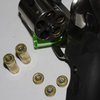Toprudder
Member
I just started reloading 44mag, and in deciding which dies to go with, I stumbled upon the Redding dual-ring sizing die. Never heard of it before. What I read about them makes sense to me. Basically, only size the lower end of the brass enough to meet SAAMI specs, but resize the area where the bullet will be seated just a little more, for proper neck tension.
I ended up going with the old standby, Lee 4 die set. I kept thinking about the dual-ring die, though, and then it dawned on me - I have two carbide rings, one in the regular sizing die, and one in the FCD. So, I tried resizing with just the FCD (with the crimp insert removed) and sure enough, it sizes the outside of the brass to about .001" under the max SAAMI spec. As I expected, there was no neck tension to hold a bullet. So then I moved to the regular resizer and resized just the top 1/3 of the case. Good neck tension as usual. It is easy to see where the normal resizing ring stopped, very visible.
But then I get to the real question - is all of this really worth it? Using the dual-ring die is supposed to keep from working the brass as hard, but that would only apply to the lower part of the brass, particularly the brass right about the web, and that leads me to believe the only failure this would help reduce would be case head separation. It seems to me the majority of revolver case failures are split mouths, not case head separations. How often does case head separation occur in revolver brass?
I ended up going with the old standby, Lee 4 die set. I kept thinking about the dual-ring die, though, and then it dawned on me - I have two carbide rings, one in the regular sizing die, and one in the FCD. So, I tried resizing with just the FCD (with the crimp insert removed) and sure enough, it sizes the outside of the brass to about .001" under the max SAAMI spec. As I expected, there was no neck tension to hold a bullet. So then I moved to the regular resizer and resized just the top 1/3 of the case. Good neck tension as usual. It is easy to see where the normal resizing ring stopped, very visible.
But then I get to the real question - is all of this really worth it? Using the dual-ring die is supposed to keep from working the brass as hard, but that would only apply to the lower part of the brass, particularly the brass right about the web, and that leads me to believe the only failure this would help reduce would be case head separation. It seems to me the majority of revolver case failures are split mouths, not case head separations. How often does case head separation occur in revolver brass?








